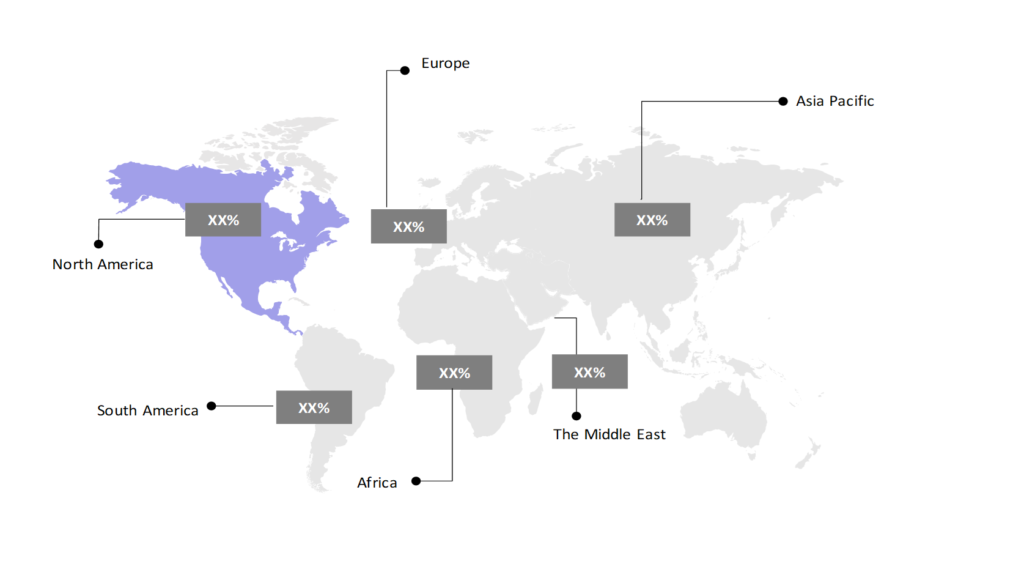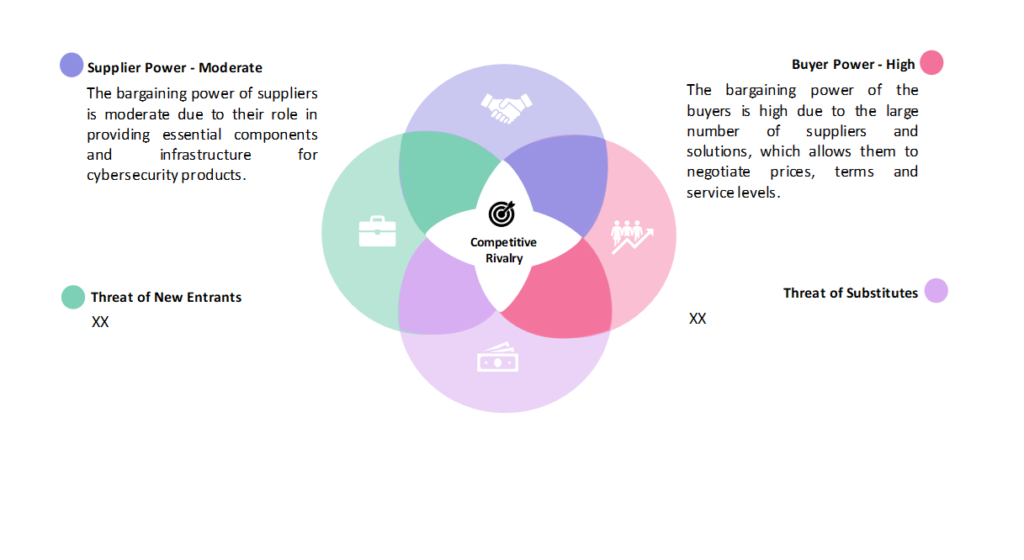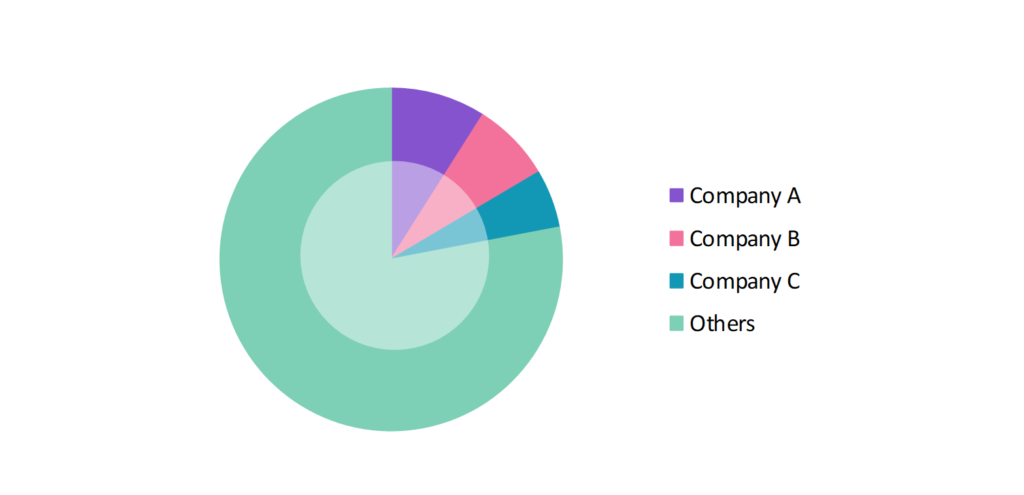Cybersecurity Market Outlook: Size, Share, Trends & Growth Analysis (2024-2029)
The report covers a comprehensive analysis segmented by Security Type (Network Security, Cloud Application Security, End-point Security, Secure Web Getaway, Application Security, Others), By Enterprise Type (Small and Medium Enterprises (SMEs), Large Enterprises), By Industry (BFSI, IT & Telecommunications, Retail, Healthcare, Government, Manufacturing, Travel & Transportation, Energy and Utilities, Others), By Geography (North America, South America, Asia Pacific, Europe, the Middle East, Africa).
Cybersecurity Market Snapshot

Cybersecurity Market Overview
The market for cybersecurity is expected to grow from an estimated $211.9 billion in 2024 to $346.71 billion in 2029. Over the projection period of 2024–2029, the worldwide cybersecurity market is growing at a compound annual growth rate (CAGR) of 10.35%.
The cyber security sector consists of many segments and submarkets, including network security, endpoint security, cloud security, application security, identity, and access management (IAM), information security and operational security. Different industry verticals have different needs for cybersecurity solutions, as industries such as finance, healthcare, government, energy, and critical infrastructure have unique characteristics and cybersecurity and regulatory responsibilities. Every industry faces unique threats and compliance challenges that impact cybersecurity spending and critical investments. Security management provided by MSSPs (Managed Security Services Providers) is becoming more popular as organizations outsource their cybersecurity operations to third-party experts.
MSSPs provide numerous services, including security monitoring, threat detection and response, vulnerability management, and incident response. The cybersecurity industry must continue to evolve in response to emerging threats, advances in technology, regulatory changes, and changing customer needs. Key elements shaping the future of cybersecurity include Zero Trust Architecture (ZTA), Extended Detection and Response (XDR), Security Intelligence (SASE), artificial intelligence-driven security analysis, and the integration of cybersecurity and other IT areas like DevSecOps and cloud-native security.
Cybersecurity Market Coverage
| Historical & Forecast Period | 2018-2029 |
| Base Year | 2023 |
| Forecast Period | 2024-2029 |
| Units | Billion US$ |
| Segments | Security Type, Enterprise Type, Industry |
| Geographies | North America, South America, Asia Pacific, Europe, The Middle East, Africa |
| Key Vendors |
Cisco Systems Inc., IBM Corp., Proofpoint, Inc., Palo Alto networks, Inc., Fortinet, Inc. |
Key Geographies of Cybersecurity Market, 2023

Porter’s 5 Forces Analysis of Cybersecurity Market

Cybersecurity Market Trends
Management detection and response (MDR), threat-hunting management, and firewall services are in high demand. User and Behavior Analysis (UEBA) solutions are highly effective at detecting insider threats, authentication-based attacks, and unauthorized behavior. Ecosystem-based adaptation (EBA) tools use machine learning algorithms to analyze user behavior patterns and analyze security postures. Extended Detection and Response (XDR) solutions have emerged as an effective method of detection and response that spans multiple areas of data security, including endpoint, network, and cloud telemetry. The XDR platform provides centralized visibility and operational responsiveness across a variety of environments.
Threat Intelligence Platforms (TIPs) and threat-hunting tools are gaining traction as organizations seek to identify and mitigate cyber threats. Threat intelligence sharing communities and networks facilitate the exchange of threat intelligence among security professionals. With the widespread use of cloud services, the demand for cloud security solutions continues to increase. These include Cloud Access Security Broker (CASB), Cloud Workload Protection Platform (CWPP), and Cloud Security Posture Management (CSPM) tools to resolve security issues in cloud environments. Security awareness programs focus on educating employees about threats, social engineering tactics, and best practices for safety and hygiene management.
Security analytics platforms powered by artificial intelligence (AI) offer a thorough overview of an organization’s security stance gathering and assessing security data from diverse origins. These platforms employ machine learning algorithms to detect patterns, connections, and valuable insights, enabling security teams to make educated decisions and efficiently prioritize security measures.
Cybersecurity Market Driving Factors
Cybersecurity is critical in ensuring business continuity and protecting against threats and disruptions. The fallout from a cyberattack can cause serious financial and reputational damage to an organization. Therefore, investing in cybersecurity measures to prevent, detect and respond to cyber incidents is critical to ensuring operational continuity. The proliferation of sensitive data and growing concerns about data breaches and privacy violations are causing organizations to pay more attention to cybersecurity. Protecting customer data, assets, financial information and other valuable information is critical to maintaining trust and complying with privacy laws.
The growing threat landscape, characterized by increasing cyberthreats such as malware, ransomware, phishing, and persistent threats (APTs), is a key driver of cybersecurity prevention. High rates of cyber-attacks and data breaches continue to highlight the importance of cybersecurity measures. Governments around the world have issued cybersecurity and data protection laws to protect sensitive information and reduce cyber risks. Complying with regulations such as the General Data Protection Regulation (GDPR), Health Insurance Portability and Accountability Act (HIPAA), Central Consumer Protection Agency (CCPA), and Payment Card Industry Data Security Standard (PCI DSS) and supporting the organization’s appropriate use of cybersecurity management and information against fines and loss of reputation.
Cybersecurity Market Challenges
Despite increased awareness of cybersecurity risks, the human element is still a weak point in maintaining cybersecurity. Employees, contractors, and third-party partners may be unfamiliar with cybersecurity best practices, leaving them vulnerable to social engineering attacks, phishing scams, and other cyber threats. Ongoing cybersecurity education and training is critical to developing a culture of security awareness. Building cybersecurity resilience and the ability to respond effectively is critical for organizations to identify, contain and mitigate cyber threats. Challenges include developing incidence response plans, conducting tabletop exercises, coordinating responses and recovering from cyber-attacks. The rapid adoption of new technologies such as cloud computing, artificial intelligence, Internet of Things (IOT), and 5G has brought with it new cybersecurity risks and challenges. Ensuring the security of this technology requires addressing issues such as data confidentiality, privacy, security by design and integration with management. Complying with cybersecurity laws and data protection laws poses challenges, especially for organizations operating in multiple jurisdictions. Regulations such as General Data Protection Regulation (GDPR), Central Consumer Protection Authority (CCPA), Health Insurance Portability and Accountability Act (HIPAA), and Payment Card Industry Data Security Standard (PCI DSS) have created stringent creations for data protection, breach notification, privacy and governance, that require compliance and data base management.
Cybersecurity Market – Key Industry News
- In March 2024, Google LLC inaugurated a new cybersecurity center in Japan, aimed at upgrading the defenses in the Asia-Pacific.
- In February 2024, Palo Alto Networks, Inc. unveiled a new Cortex platform offering for endpoint security aimed at assisting customers in expediting platformization and enhancing their endpoint protection capabilities.
- In September 2023, Proofpoint, Inc. a cybersecurity and compliance firm, has introduced a range of fresh features and capabilities within its security solutions aimed at disrupting threats across the key stages of the cyberattack kill chain. These newly announced capabilities encompass the company’s Aegis Threat Protection, Identity Threat Defense, and Sigma Information Protection platforms.
Cybersecurity Market Competitive Landscape
The participants in the global cybersecurity industry are always developing their strategies to preserve a competitive advantage. The companies primarily use acquisitions, R&D, partnerships, and technological launches. Several important entities in the cybersecurity market include Cisco Systems Inc., IBM Corp., Proofpoint, Inc., Palo Alto networks, Inc., Fortinet, Inc., and others.
The cybersecurity market exhibits intense competition, driving vendors to consistently innovate to anticipate emerging threats and address the varied security requirements of organizations spanning diverse industries and geographical regions. This competitive environment features a blend of well-established entities, pioneering startups, niche vendors, and service providers, all delivering a broad spectrum of cybersecurity solutions and services.
Cybersecurity Market Company Share Analysis, 2023 (%)

Cybersecurity Market – Key Companies

Reason to Buy from us

Table of Contents
| 1. Introduction |
|---|
| 1.1. Research Methodology |
| 1.2. Scope of the Study |
| 2. Market Overview / Executive Summary |
| 2.1. Global Cybersecurity Market (2018 – 2022) |
| 2.2. Global Cybersecurity Market (2023 – 2029) |
| 3. Market Segmentation |
| 3.1. Global Cybersecurity Market by Security Type |
| 3.1.1. Network Security |
| 3.1.2. Cloud Application Security |
| 3.1.3. End-point Security |
| 3.1.4. Secure Web Getaway |
| 3.1.5. Application Security |
| 3.1.6. Others |
| 3.2. Global Cybersecurity Market by Enterprise Type |
| 3.2.1. Small and Medium Enterprises (SMEs) |
| 3.2.2. Large Enterprises |
| 3.3. Global Cybersecurity Market by Industry |
| 3.3.1. BFSI |
| 3.3.2. IT & Telecommunications |
| 3.3.3. Retail |
| 3.3.4. Healthcare |
| 3.3.5. Government |
| 3.3.6. Manufacturing |
| 3.3.7. Travel & Transportation |
| 3.3.8. Energy and Utilities |
| 3.3.9. Others |
| 4. Regional Segmentation |
| 4.1. North America |
| 4.1.1. The U.S |
| 4.1.2. Canada |
| 4.1.3. Mexico |
| 4.2. South America |
| 4.2.1. Brazil |
| 4.2.2. Argentina |
| 4.2.3. Colombia |
| 4.2.4. Chile |
| 4.2.5. Rest of South America |
| 4.3. Asia Pacific |
| 4.3.1. China |
| 4.3.2. India |
| 4.3.3. Japan |
| 4.3.4. South Korea |
| 4.3.5. Rest of Asia Pacific |
| 4.4. Europe |
| 4.4.1. UK |
| 4.4.2. Germany |
| 4.4.3. Italy |
| 4.4.4. France |
| 4.4.5. Spain |
| 4.4.6. Rest of Europe |
| 4.5. The Middle East |
| 4.5.1. Turkey |
| 4.5.2. UAE |
| 4.5.3. Saudi Arabia |
| 4.5.4. Rest of the Middle East |
| 4.6. Africa |
| 4.6.1. Egypt |
| 4.6.2. South Africa |
| 4.6.3. Rest of Africa |
| 5. Value Chain Analysis of the Global Cybersecurity Market |
| 6. Porter Five Forces Analysis |
| 6.1. Threats of New Entrants |
| 6.2. Threats of Substitutes |
| 6.3. Bargaining Power of Buyers |
| 6.4. Bargaining Power of Suppliers |
| 6.5. Competition in the Industry |
| 7. Trends, Drivers and Challenges Analysis |
| 7.1. Market Trends |
| 7.1.1. Market Trend 1 |
| 7.1.2. Market Trend 2 |
| 7.1.3. Market Trend 3 |
| 7.1.4. Market Trend 4 |
| 7.1.5. Market Trend 5 |
| 7.2. Market Drivers |
| 7.2.1. Market Driver 1 |
| 7.2.2. Market Driver 2 |
| 7.2.3. Market Driver 3 |
| 7.2.4. Market Driver 4 |
| 7.2.5. Market Driver 5 |
| 7.3. Market Challenges |
| 7.3.1. Market Challenge 1 |
| 7.3.2. Market Challenge 2 |
| 7.3.3. Market Challenge 3 |
| 7.3.4. Market Challenge 4 |
| 7.3.5. Market Challenge 5 |
| 8. Regulatory Landscape |
| 9. Competitive Landscape |
| 9.1. Cisco Systems Inc. |
| 9.2. IBM Corp. |
| 9.3. Proofpoint, Inc. |
| 9.4. Palo Alto networks, Inc. |
| 9.5. Fortinet, Inc. |
| 9.6. Company 6 |
| 9.7. Company 7 |
| 9.8. Company 8 |
| 9.9. Company 9 |
| 9.10. Company 10 |
Cybersecurity Market – Frequently Asked Questions (FAQs)
What is the current size of the global cybersecurity market?
The market size for the global cybersecurity market in 2024 is $211.9 Bn.
Who are the major vendors in the global cybersecurity market?
The major vendors in the global cybersecurity market are Cisco Systems Inc., IBM Corp., Proofpoint, Inc., Palo Alto networks, Inc., Fortinet, Inc.
Which segments are covered under the global cybersecurity market segments analysis?
This report offers in-depth insights into each security type, enterprise type, industry.
